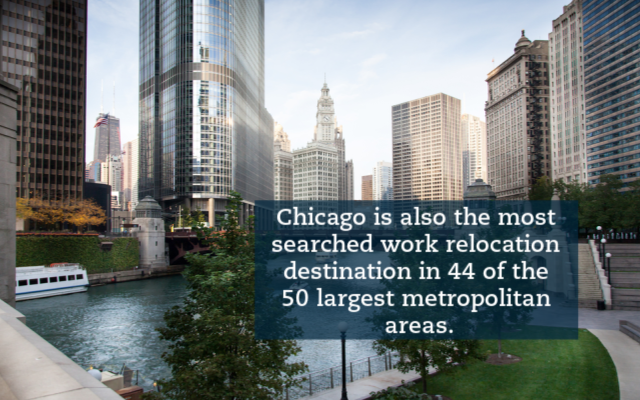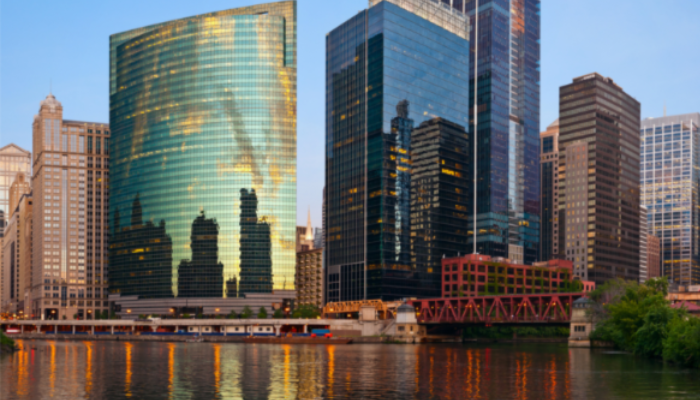Since Chicago’s incorporation as a city in 1837, its strategic location has spurred commerce, industry, and near-constant evolution. Mark Twain rightly observed, “She is always a novelty; for she is never the Chicago you saw when you passed through the last time.”
Since the famous writer penned those words, the qualities that inspired his insight have been multiplied many times over. Today, the city delivers global access to the heart of America. Chicago’s two major international airports, O’Hare and Midway, serve 100 million passengers each year. O’Hare arrivals and departures rank second only to London’s Heathrow. Residents enjoy non-stop service to more than 60 international destinations. One-fourth of all U.S. freight moves through Chicago, which is home to America’s largest inland port, CenterPoint Intermodal Center (CIC).
The GDP of the Chicago metropolitan statistical area exceeds $689 billion, making it the third-largest urban economy in North America. The region employs 4.8 million workers, according to the U.S. Bureau of Labor Statistics, and there are more than 400 corporate headquarters in the greater Chicago area. Ten Fortune 500 companies maintain their headquarters in Chicago, including Boeing and Archer Daniels Midland.
The economy is also one of the most diversified in the country. Although Chicago’s biggest sectors include manufacturing, printing, finance, and food processing, there is no one industry employing more than 12 percent of the workforce, according to World Business Chicago.
Life in Chicago
There’s something for everyone in Chicago. The Art Institute, Second City, and the Goodman Theatre are world-renowned art and entertainment institutions. Chicago is also considered one of the best cities for sports fans in the U.S. The NFL’s Chicago Bears play their home games at Soldier Field, while the NBA’s Bulls and the NHL’s Blackhawks compete at the United Center. Historic Wrigley Field is the home of the Chicago Cubs. For shoppers, the Magnificent Mile is the centerpiece of the city’s vibrant retail scene.
More than 200 colleges and universities dot the metropolitan area. Schools like the University of Chicago and Northwestern University deliver world-class educational and research opportunities. The Chicago Park District is the largest municipal park manager in the country. It oversees 600 parks and 8,800 acres of green space. Chicago’s twenty-six miles of lakefront includes 25 beaches and 19 miles of bike paths.
Examples of bold architecture include both the iconic and the ultra-modern. Historic structures link 21st century Chicago to its considerable history. Frank Lloyd Wright’s design genius is displayed at The Rookery, and the famous Wrigley Building stuns visitors with its six shades of gleaming white terra cotta.
At the same time, dazzling examples of contemporary architecture embrace the future of Chicago. The 81-story Aqua Building is the recipient of the 2009 Emporis Best New Skyscraper of the Year Award. The 101-story Vista Tower will soon become the city’s third-tallest building.
Chicago draws tourists from all over the world. In 2017, 2018, and again in 2019, CondeNast Traveler named Chicago the best large city to visit. Visitors gather at hundreds of famous venues, including Millennium Park, the Museum of Science and Industry, and the Navy Pier, among many others. Lincoln Park is a six-mile-long ribbon of tranquility winding along the shores of Lake Michigan. The nearby Lincoln Park Zoo is the nation’s only free, privately managed zoo. The Pride of Chicago campaign, which raised $135 million to expand the Lincoln Park Zoo and renovate iconic Chicago landmarks within it, has injected new life into this city treasure.
Residents and tourists alike enjoy Lake Michigan’s soothing effects on Chicago’s weather. Compared to inland areas, the city of Chicago is often cooler in the summer and warmer in the winter. Average highs range from 31° F in January to 84° F in July. And thanks to an average depth of 279 feet, Lake Michigan readily supplies Chicago with almost one billion gallons of water per day.
Market Overview
The Chicago rental market is a highly seasonal one driven by younger, tech-savvy renters. Approximately 70 percent of annual turnover is during the spring and summer.
Chicago rents have risen ever since the recession more than a decade ago. Construction slowed in the immediate aftermath of the recession, and since then, demand is outpacing supply. Sustained job growth is one important reason. The downtown area employs 613,000 workers, up 134,000 in the past decade. By 2030, that number is projected to exceed 750,000. As a result, demand appears more than adequate to absorb the thousands of apartments coming to the Loop. According to Chicago Business, there will be 2,900 units added in 2020 and 3,700 more in 2021.
 Chicago is also the most searched work relocation destination in 44 of the 50 largest metropolitan areas. In fact, Chicago has led in corporate relocations for six consecutive years. As MarketWatch observed, “Tons of renters from other cities want to move here—and few people want to leave.” The result is a rental market defined by its stability and opportunity.
Chicago is also the most searched work relocation destination in 44 of the 50 largest metropolitan areas. In fact, Chicago has led in corporate relocations for six consecutive years. As MarketWatch observed, “Tons of renters from other cities want to move here—and few people want to leave.” The result is a rental market defined by its stability and opportunity.
A Zillow study reveals that 86 percent of rent searches are local, one of the highest levels in the country. For many, rents are still modest relative to income. Chicago compares very favorably to places like Los Angeles and Miami where the median rent consumes more than 40 percent of income.
In 2019, occupancy rates rose from 93.2 to 94.3 percent for Class A downtown buildings. In Class B buildings, occupancy rates increased from 94.1 to 95.1 percent. A growing preference for the urban lifestyle among renters is helping to sustain and strengthen the multifamily market in Chicago.
The Future of Chicago
Chicago is as dynamic, relevant, and aspirational as ever in 2020. The city remains an essential hub and powerhouse for American commerce and transportation, and Chicago will continue to draw an abundance of renters who seek job opportunities, culture, and the hustle and bustle of the big city, without sacrificing affordability.
To learn more about Draper and Kramer’s properties in Chicago, visit draperandkramer.com.

Chicago remains an essential hub and powerhouse for American commerce and transportation, and it will continue to draw an abundance of renters who seek job opportunities, culture, and the hustle and bustle of the big city, without sacrificing affordability.